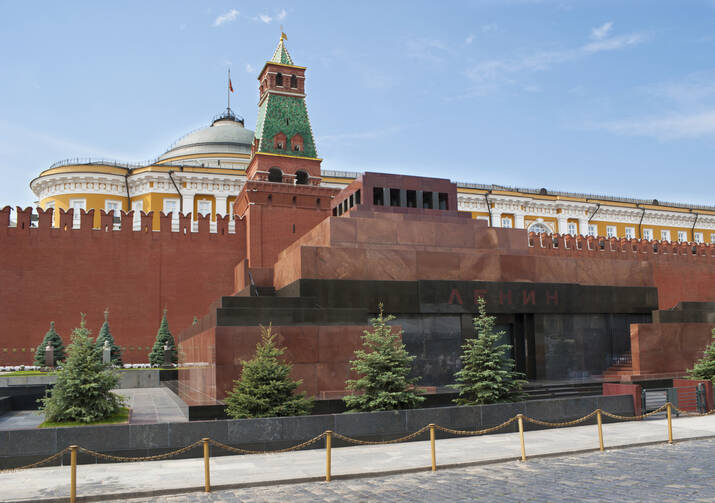MOSCOW, June 4, 2016—Yesterday afternoon I came face to face with Vladimir Lenin. I have had similar brief encounters with the corpses of North Vietnam’s Ho Chi Minh and China’s Chairman Mao, both laid out in their tombs—Minh in a tiny house on a lake in Hanoi, Mao's in China on Tiananmen Square—but this was a different experience. Red Square was bustling with thousands of happy mostly young citizens enjoying a huge book show and two couples surrounded by more young people, just married, were posing for portraits. Suddenly a long line of young men in uniform came marching through, just as in the park across the street 20 troops on horseback, led by an officer on a proud white mount, repeatedly made the rounds. On the side, in a fenced in area, several hundred lined up for security checks for the tomb.
Young men in military blue stood guard as we made our way into the mausoleum and then in total darkness, down stairs painted black and into a corridor so dark we had to help each other maneuver without falling. And there he was. Unlike Mao’s vault, we were not zipped along but had a few minutes to look. It has been suggested that although reportedly the body is immersed every 18 months in a chemical bath to preserve it, and we are looking at wax. Though he died in 1924 at 54 he could pass for 25, dressed in black with a red lining, his little beard clipped, his right hand clenched in a fist and his left with fingers extended.
Joseph Stalin, when he died in 1954, was displayed at his side, but in the 1960s Khrushchev had him buried somewhere else. Today, since Russia has been rethinking its history and identity for 50 years, and statues of Lenin are being torn down or relocated in former communist countries, there is a movement to replant the very founder of the communist state somewhere else. But for the time being President Vladimir Putin deems this man as relevant to the identity of the nation Putin wishes to control and form.
With an overnight flight to London, I arrived in Moscow Friday afternoon and came here crammed into in a seat too small for me and unable to read much or sleep at all. One of the several wrong ideas that have misled me for many years was that Moscow had the Kremlin with its Red Square and cathedrals, but was otherwise a not-beautiful city. I was wrong. The countryside from the airport is all forests until the big suburban aging apartment buildings in the suburbs; but the city itself is largely two-or-three story homes and businesses painted white or yellow or light tan to brighten the atmosphere during cold dark winters. The quiet Moskva River, ferry boats chugging on the surface, winds in from the South and bends out the other to the Southeast. Parks and flower beds bloom throughout, the golden domes of countless churches and cathedrals glisten in the June sun and the giant red brick wall and towers of the Kremlin—the governmental city within the city—loom high above the river side. There is absolutely no trash on the sidewalks and over 48 hours I saw only one person begging, whereas in New York a three-block walk to buy a newspaper presents the walker with at least five homeless men sprawled on the sidewalk or propped against a pole. Though probably not a “typical” 19 year old, our friendly, very polite waiter told us he is studying language and hospitality at the university and, along with core subjects, now speaks Russian, English, German and Spanish.
In our first afternoon we visited the Armory Chamber, a collection of costumes—Peter the Great’s (he was 6’9) boots and uniform, Catherine the Great’s royal gowns with her waist squeezed down to about 15 inches, knights in armor on the stuffed horses they used to ride and the helmet of Prince Ivan, son of Ivan the Terrible, who was somehow killed accidentally when his father was in one of his unpredictable rages. A painting of the father weeping over his bloodied, dying son hangs in the Tretyakov Gallery we visited the next day.
In the first two days we visited at least three Orthodox churches and cathedrals with their soaring columns completely painted with biblical and church historical scenes, and the walls totally covered four rows one upon the other, with smaller paintings or icons first in a series of feast days, next episodes from the life of Christ, the next lives of saints.
My companions include four men and five women. I had expected married couples, but spouses seemed to have stayed home. Several are writers or journalists who have been to Vietnam and all are interested in politics and the arts. One woman is our tour director and our traveling expert is Serge Schmemann, born in France, educated at Yale and Columbia and living in Russia for years as foreign correspondent for The New York Times. Along with Serge’s continued guidance we have had three lectures and discussions with a radio broadcast journalist and Mikhail S. Gorbachev’s interpreter and adviser. Even in these two and a half days I have developed a deeper understanding of and affection for these millions of people whom we may have thought we knew as we lived through a World War with them as allies and later prepared to blow one another to bits with our nuclear weapons.
It is now 9:00 p.m. and the sun has not yet set and it will have risen before 4:00 a.m. when I have failed to sleep. More on this from St. Petersburg.








